Abstract
We reported that suramin is an effective chemosensitizer at noncytotoxic concentrations (<50 μM); this effect was observed in multiple types of human xenograft tumors in vitro and in vivo. Clinical evaluation of noncytotoxic suramin is ongoing. Because (a) suramin inhibits reverse transcriptase, (b) telomerase is a reverse transcriptase, and (c) inhibition of telomerase enhances tumor chemosensitivity, we studied the pharmacodynamics of noncytotoxic suramin on telomerase activity and telomere length in cultured cells and tumors grown in animals. In three human cancer cells that depend on telomerase for telomere maintenance (pharynx FaDu, prostate PC3, breast MCF7), suramin inhibited telomerase activity in cell extracts and intact cells at concentrations that exhibited no cytotoxicity (IC50 of telomerase was between 1 and 3 μM vs. >60 μM for cytotoxicity), and continuous treatment at 10–25 μM for 6 weeks resulted in gradual telomere shortening (maximum of 30%) and cell senescence (measured by β-galactosidase activity and elevation of mRNA levels of two senescence markers p16 and p21). In contrast, noncytotoxic suramin did not shorten the telomere in telomerase-independent human osteosarcoma Saos-2 cells. In mice bearing FaDu tumors, treatment with noncytotoxic suramin for 6 weeks resulted in telomere erosion in >95% of the tumor cells with an average telomere shortening of >40%. These results indicate noncytotoxic suramin inhibits telomerase, shortens telomere and induces cell senescence, and suggest telomerase inhibition as a potential mechanism of its chemosensitization.







Similar content being viewed by others
Abbreviations
- CxT50 :
-
Concentration-time product (total drug exposure) for 50% effect
- DC50 :
-
Drug concentration causing 50% cell death
- FBS:
-
Fetal bovine serum
- FISH:
-
Fluorescence in situ hybridization
- IC50 :
-
50% inhibitory drug concentration
- hTERT:
-
Reverse transcriptase component of human telomerase
- hTR:
-
RNA component of human telomerase
- MEM:
-
Minimum essential medium
- PBS:
-
Phosphate-buffered saline
- TALA:
-
Solution hybridization-based telomere amount and length assay
- TRAP:
-
Telomeric repeat amplification protocol
References
Zakian VA. Telomeres: beginning to understand the end. Science. 1995;270:1601–7.
Hemann MT, Strong MA, Hao LY, Greider CW. The shortest telomere, not average telomere length, is critical for cell viability and chromosome stability. Cell. 2001;107:67–77.
Kuilman T, Michaloglou C, Mooi WJ, Peeper DS. The essence of senescence. Genes Dev. 2010;24:2463–79.
Abdallah P, Luciano P, Runge KW, Lisby M, Geli V, Gilson E, et al. A two-step model for senescence triggered by a single critically short telomere. Nat Cell Biol. 2009;11:988–93.
Feng J, Funk WD, Wang SS, Weinrich SL, Avilion AA, Chiu CP, et al. The RNA component of human telomerase. Science. 1995;269:1236–41.
Au JL, Kumar RR, Li D, Wientjes MG. Kinetics of hallmark biochemical changes in paclitaxel-induced apoptosis. AAPS Pharm Sci. 1999;1:E8.
Moos PJ, Fitzpatrick FA. Taxanes propagate apoptosis via two cell populations with distinctive cytological and molecular traits. Cell Growth Differ. 1998;9:687–97.
Stone AA, Chambers TC. Microtubule inhibitors elicit differential effects on MAP kinase (JNK, ERK, and p38) signaling pathways in human KB-3 carcinoma cells. Exp Cell Res. 2000;254:110–9.
Strahl C, Blackburn EH. Effects of reverse transcriptase inhibitors on telomere length and telomerase activity in two immortalized human cell lines. Mol Cell Biol. 1996;16:53–65.
Gangemi RMR, Santamara B, Bargellesi A, Cosulich E, Fabbi M. Late apoptotic effects of taxanes on K562 erythroleukemia cells: apoptosis is delayed upstream of caspase-3 activation. Int J Cancer. 2000;85:527–33.
Campisi J, d’Adda di FF. Cellular senescence: when bad things happen to good cells. Nat Rev Mol Cell Biol. 2007;8:729–40.
Kelland L. Targeting the limitless replicative potential of cancer: the telomerase/telomere pathway. Clin Cancer Res. 2007;13:4960–3.
Kim NM, Piatzszek MS, Prowese KR, Harley CB, West MD, Ho PL, et al. Specific association of human telomerase activity with immortal cells and cancer. Science. 1994;266:2011–5.
Harley CB. Telomerase and cancer therapeutics. Nat Rev Cancer. 2008;8:167–79.
Lee KH, Rudolph KL, Ju YJ, Greenberg RA, Cannizzaro L, Chin L, et al. Telomere dysfunction alters the chemotherapeutic profile of transformed cells. Proc Natl Acad Sci U S A. 2001;98:3381–6.
Mo Y, Gan Y, Song S-H, Johnston J, Xiao X, Wientjes MG, et al. Simultaneous targeting of telomeres and telomerase as a cancer therapeutic approach. Cancer Res. 2003;63:579–85.
Stein CA. Suramin: a novel antineoplastic agent with multiple potential mechanisms of action. Cancer Res. 1993;54:2239–48.
Church D, Zhang Y, Rago R, Wilding G. Efficacy of suramin against human prostate carcinoma DU145 xenograft in nude mice. Cancer Chemother Pharmacol. 1999;43:198–204.
Vincent TS, Hazen-Martin DJ, Garvin AJ. Inhibition of insulin like growth factor II autocrine growth of Wilms’ tumor by suramin in vitro and in vivo. Cancer Lett. 1996;103:49–56.
Yonega R, Williams P, Rhine C, Boyce BF, Dunstan C, Mundy GR. Suramin suppresses hypercalcemia and osteoclastic bone resorption in nude mice bearing a human squamous cancer. Cancer Res. 1995;55:1989–93.
Song S, Wientjes MG, Walsh C, Au JL. Nontoxic doses of suramin enhance activity of paclitaxel against lung metastases. Cancer Res. 2001;61:6145–50.
Song S, Wientjes MG, Gan Y, Au JL. Fibroblast growth factors: an epigenetic mechanism of broad spectrum resistance to anticancer drugs. Proc Natl Acad Sci U S A. 2000;97:8658–63.
Zhang Y, Song S, Yang F, Au JL, Wientjes MG. Nontoxic doses of suramin enhance activity of doxorubicin in prostate tumors. J Pharmacol Exp Ther. 2001;299:426–33.
Lu Z, Wientjes TS, Au JL. Nontoxic suramin treatments enhance docetaxel activity in chemotherapy-pretreated non-small cell lung xenograft tumors. Pharm Res. 2005;22:1069–78.
Yu B, Song S-H, Wientjes MG, Au JL. Suramin enhances activity of CPT-11 in human colorectal xenograft tumors. Proc Am Assoc Cancer Res. 2003;44.
ClinTrials.Gov. Available from: https://clinicaltrials.gov/ct2/show/NCT01671332.
Au JL, Olencki T, Wientjes MG, Otterson G, Saab T, Grainger A, et al. A phase I study of nontoxic suramin as a chemosensitizer in the pretreated/refractory non-small cell lung cancer (NSCLC) patients. J Thorac Oncol. 2007;2:S663–4.
George S, Dreicer R, Au JL, Shen T, Rini BI, Roman S, et al. Phase I/II trial of 5-fluorouracil and a noncytotoxic dose level of suramin in patients with metastatic renal cell carcinoma. Clin Genitourin Cancer. 2008;6:79–85.
Lam ET, Au JL, Otterson GA, Wientjes MG, Chen L, Shen T, et al. Phase I trial of non-cytotoxic suramin as a modulator of docetaxel and gemcitabine therapy in previously treated patients with non-small cell lung cancer. Cancer Chemother Pharmacol. 2010;66:1019–29.
Lustberg MB, Pant S, Ruppert AS, Shen T, Wei Y, Chen L, et al. Phase I/II trial of non-cytotoxic suramin in combination with weekly paclitaxel in metastatic breast cancer treated with prior taxanes. Cancer Chemother Pharmacol. 2012;70:49–56.
Olencki T, Wientjes MG, Otterson G, Saab T, Grainger A, Yeh T, et al. Modulation of chemotherapy resistance with low dose suramin in refractory non-small cell lung cancer (NSCLC) patients: a phase I study of sequential non-cross resistant chemotherapy. J Clin Oncol. 2005;23:2104.
Shapiro CL, Sheils D, Barton L, Young D, Shen T, Chen L, et al. CTEP-sponsored phase I/II trial of paclitaxel and low dose suramin in metastatic breast cancer. Breast Cancer Res Treat. 2007;106:S270.
Villalona-Calero MA, Otterson GA, Kanter S, Young D, Fischer B, Straiko M, et al. A phase I, pharmacokinetic (PK), and biological study of FGF inhibition modulating paclitaxel/carboplatin (P/C) chemotherapy in non-small cell lung cancer (NSCLC) patients (pts). Clin Cancer Res. 2001;417:3738S.
Villalona-Calero MA, Otterson GA, Wientjes MG, Weber F, Bekaii-Saab T, Young D, et al. Noncytotoxic suramin as a chemosensitizer in patients with advanced non-small-cell lung cancer: a phase II study. Ann Oncol. 2008;19:1903–9.
Villalona-Calero MA, Wientjes MG, Otterson GA, Kanter S, Young D, Murgo AJ, et al. Phase I study of low-dose suramin as a chemosensitizer in patients with advanced non-small cell lung cancer. Clin Cancer Res. 2003;9:3303–11.
Erguven M, Akev N, Ozdemir A, Karabulut E, Bilir A. The inhibitory effect of suramin on telomerase activity and spheroid growth of C6 glioma cells. Med Sci Monit. 2008;14:BR165–73.
Trieb K, Blahovec H. Suramin suppresses growth, alkaline-phosphatase and telomerase activity of human osteosarcoma cells in vitro. Int J Biochem Cell Biol. 2003;35:1066–70.
Gan Y, Mo Y, Johnston J, Lu J, Wientjes MG, Au JL. Telomere maintenance in telomerase-positive human ovarian SKOV-3 cells cannot be retarded by complete inhibition of telomerase. FEBS Lett. 2002;527:10–4.
Kuh HJ, Jang SH, Wientjes MG, Au JL. Computational model of intracellular pharmacokinetics of paclitaxel. J Pharmacol Exp Ther. 2000;293:761–70.
Gao Y, Li M, Chen B, Shen Z, Guo P, Wientjes MG, et al. Predictive models of diffusive nanoparticle transport in 3-dimensional tumor cell spheroids. AAPS J. 2013;15:816–31.
Gan Y, Lu J, Johnson A, Wientjes MG, Schuller DE, Au JL. A quantitative assay of telomerase activity. Pharm Res. 2001;18:488–93.
Bryan TM, Englezou A, Dalla-Pozza L, Dunham MA, Reddel RR. Evidence for an alternative mechanism for maintaining telomere length in human tumors and tumor-derived cell lines. Nat Med. 1997;3:1271–4.
Gan Y, Engelke KJ, Brown CA, Au JL. Telomere amount and length assay. Pharm Res. 2001;18:1655–9.
Cawthon RM. Telomere length measurement by a novel monochrome multiplex quantitative PCR method. Nucleic Acids Res. 2009;37:e21.
Hu L. Suramin pharmacokinetics after regional or systemic administration. Dissertation, The Ohio State University, 2005
Dimri GP, Lee X, Basile G, Acosta M, Scott G, Roskelley C, et al. A biomarker that identifies senescent human cells in culture and in aging skin in vivo. Proc Natl Acad Sci U S A. 1995;92:9363–7.
Eisenberger MA, Reyno LM. Suramin. Cancer Treat Rev. 1994;20:259–73.
Song S, Yu B, Wei Y, Wientjes MG, Au JL. Low-dose suramin enhanced paclitaxel activity in chemotherapy-naive and paclitaxel-pretreated human breast xenograft tumors. Clin Cancer Res. 2004;10:6058–65.
Xin Y, Lyness G, Chen D, Song S, Wientjes MG, Au JL. Low dose suramin as a chemosensitizer of bladder cancer to mitomycin C. J Urol. 2005;174:322–7.
Artandi SE, DePinho RA. Telomeres and telomerase in cancer. Carcinogenesis. 2010;31:9–18.
Wojtyla A, Gladych M, Rubis B. Human telomerase activity regulation. Mol Biol Rep. 2011;38:3339–49.
Raymond E, Soria JC, Izbicka E, Boussin F, Hurley L, Von Hoff DD. DNA G-quadruplexes, telomere-specific proteins and telomere-associated enzymes as potential targets for new anticancer drugs. Invest New Drugs. 2000;18:123–37.
White LK, Wright WE, Shay JW. Telomerase inhibitors. Trends Biotechnol. 2001;19:114–20.
De Clercq E. Suramin: a potent inhibitor of the reverse transcriptase of RNA tumor viruses. Cancer Lett. 1979;8:9–22.
La Rocca RV, Danesi R, Cooper MR, Jamis-Dow CA, Ewing MW, Linehan WM, et al. Effect of suramin on human prostate cancer cells in vitro. J Urol. 1991;145:393–8.
Haïk S, Gauthier LR, Granotier C, Peyrin J-M, Lages CS, Dormont D, et al. Fibroblast growth factor 2 up regulates telomerase activity in neural precursor cells. Oncogene. 2000;19:2957–66.
Tsumuki H, Hasunuma T, Kobata T, Kato T, Uchida A, Nishioka K. Basic FGF-induced activation of telomerase in rheumatoid synoviocytes. Rheumatol Int. 2000;19:123–8.
Li H, Zhao L, Yang Z, Funder JW, Liu JP. Telomerase is controlled by protein kinase C-alpha in human breast cancer cells. J Biol Chem. 1998;273:33436–42.
Yu CC, Lo SC, Wang TC. Telomerase is regulated by protein kinase C-zeta in human nasopharyngeal cancer cells. Biochem J. 2001;355:459–64.
Kang SS, Kwon T, Kwon DY, Do SI. Akt protein kinase enhances human telomerase activity through phosphorylation of telomerase reverse transcriptase subunit. J. Biol Chem. 1999;274:13085–90.
Marshall JL. Maintenance therapy for colorectal cancer. Oncology (Williston Park). 2014;28:322–4
Khalique S, Hook JM, Ledermann JA. Maintenance therapy in ovarian cancer. Curr Opin Oncol. 2014;26:521–8
Acknowledgments
This study was supported in part by a research grant RO1CA77091 from the National Cancer Institute, NIH, DHHS.
Author information
Authors and Affiliations
Corresponding author
Rights and permissions
About this article
Cite this article
Gan, Y., Lu, J., Yeung, B.Z. et al. Pharmacodynamics of Telomerase Inhibition and Telomere Shortening by Noncytotoxic Suramin. AAPS J 17, 268–276 (2015). https://doi.org/10.1208/s12248-014-9703-7
Received:
Accepted:
Published:
Issue Date:
DOI: https://doi.org/10.1208/s12248-014-9703-7




